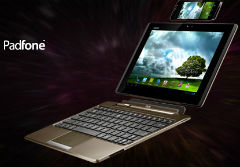If modular computing is the future, Asus is trying to get a head start with the Padfone.
On its own, the Padfone is an ordinary Android smartphone. Its above-average specs include a 1.5 GHz dual-core processor, a 4.3-inch Super AMOLED display with 960-by-540 resolution, an 8-megapixel rear camera and a VGA front camera. It runs the latest version of Android, known as Ice Cream Sandwich.
(MORE: Why the iPhone Has a Head Start on the Future of Personal Computing)
The magic happens when you slide the Padfone into its tablet accessory, dubbed the “Padfone Station,” which turns the device into a 10.1-inch Android slab. If you want to get really crazy, you can then connect the tablet to another dock with a keyboard and trackpad, essentially turning the Padfone into an Android-based laptop.
Should you get a phone call while the Padfone is tucked away in its tablet dock, the included stylus doubles as a headset. (Just make sure no one sees you talking to your pen.)
 Although I haven’t seen the Padfone up close, I’m fascinated by the concept. Having one device that acts as a phone, tablet and laptop means you don’t have to worry about transferring files or carrying other computing devices around. Although an Android computer won’t be as capable as a Windows PC or a Mac, it’s fine for leisure and light work.
Although I haven’t seen the Padfone up close, I’m fascinated by the concept. Having one device that acts as a phone, tablet and laptop means you don’t have to worry about transferring files or carrying other computing devices around. Although an Android computer won’t be as capable as a Windows PC or a Mac, it’s fine for leisure and light work.
Much of the Padfone’s allure, however, will be determined by pricing and availability. Asus is going to sell the Padfone Station and the laptop dock as optional accessories, but the company hasn’t yet named prices for the phone or its add-ons. And in the United States, where Asus has not released any smartphones of its own, it’s not clear whether wireless carriers will embrace the Padfone concept. If Asus has to sell the phone without a carrier subsidy, it may be doomed to obscurity in the United States.
Asus says we’ll find out more about pricing and availability in April. According to SlashGear, a 4G LTE model will follow. That version, if anything, has the best chance of attracting speed-obsessed U.S. wireless carriers.
(MORE: What’s the Deal with 4G?)

